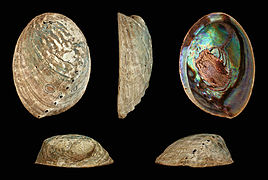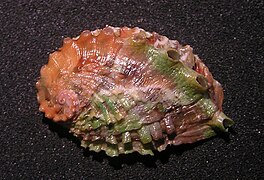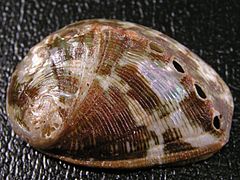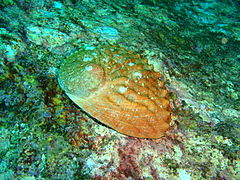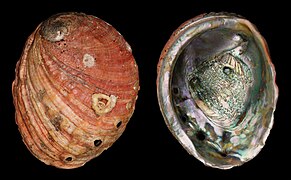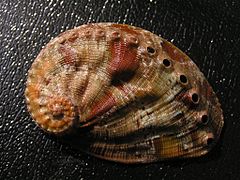
Abalone is a common name for any of a group of small to very large marine gastropod molluscs in the family Haliotidae. Other common names are ear shells, sea ears, and, rarely, muttonfish or muttonshells in parts of Australia, ormer in the UK, perlemoen in South Africa, and pāua in New Zealand. Abalones are marine snails. Their taxonomy puts them in the family Haliotidae, which contains only one genus, Haliotis, which once contained six subgenera. These subgenera have become alternative representations of Haliotis. The number of species recognized worldwide ranges between 30 and 130 with over 230 species-level taxa described. The most comprehensive treatment of the family considers 56 species valid, with 18 additional subspecies. The shells of abalones have a low, open spiral structure, and are characterized by several open respiratory pores in a row near the shell's outer edge. The thick inner layer of the shell is composed of nacre (mother-of-pearl), which in many species is highly iridescent, giving rise to a range of strong, changeable colors which make the shells attractive to humans as decorative objects, jewelry, and as a source of colorful mother-of-pearl. The flesh of abalones is widely considered to be a desirable food, and is consumed raw or cooked by a variety of cultures.

Haliotis cracherodii, the black abalone, is a species of large edible sea snail, a marine gastropod mollusk in the family Haliotidae, the abalones.

Haliotis australis, common name the queen pāua,yellowfoot pāua, or austral abalone, is a species of edible sea snail, a marine gastropod mollusk in the family Haliotidae, the abalones.

Haliotis kamtschatkana, common name the northern abalone, threaded abalone, or pinto abalone, is a species of large sea snail, a marine gastropod mollusc in the family Haliotidae, the abalones.

Haliotis asinina, common name the ass's-ear abalone, is a fairly large species of sea snail, a tropical gastropod mollusk in the family Haliotidae, the abalones, also known as ormers or paua. Both the common name and the scientific name are based on the shape of the shell, which is long, narrow and curved, resembling the shape of a donkey's ear.

The green ormer is a northeast Atlantic and Mediterranean species of sea snail, a coastal marine gastropod mollusc in the family Haliotidae, the abalones or ormer snails.

The pink abalone, scientific name Haliotis corrugata, is a species of large edible sea snail, a marine gastropod mollusk in the family Haliotidae, the abalones.
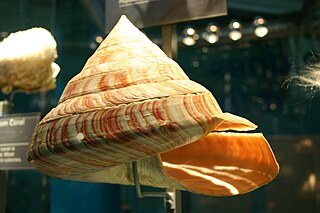
Pleurotomariacea is one of two names that are used for a taxonomic superfamily of sea snails that are an ancient lineage and are well represented in the fossil record. The name Pleurotomariacea is used by paleontologists, who, because they usually have only the hard parts of mollusks to study, often use a slightly different scheme of classification from that used by scientists who study living mollusks.

The blacklip abalone, Haliotis rubra, is an Australian species of large, edible sea snail, a marine gastropod mollusk in the family Haliotidae, the abalones.

Haliotis gigantea, common name the giant abalone, is a species of sea snail, a marine gastropod mollusk in the family Haliotidae, the abalones. It is also known as Siebold's abalone, after Philipp Franz von Siebold.

Haliotis cyclobates, common name the whirling abalone or the circular ear shell, is a species of sea snail, a marine gastropod mollusk in the family Haliotidae, the abalones.

Haliotis fulgens, commonly called the green abalone, is a species of large sea snail, a marine gastropod mollusc in the family Haliotidae, the abalones. The shell of this species is usually brown, and is marked with many low, flat-topped ribs which run parallel to the five to seven open respiratory pores that are elevated above the shell's surface. The inside of the shell is an iridescent blue and green.

Haliotis glabra, commonly called glistening abalone, is a species of sea snail, a marine gastropod mollusk in the family Haliotidae, the abalones.
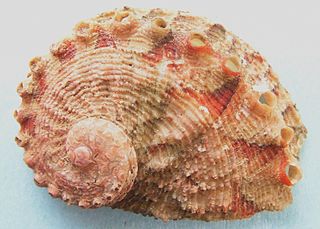
Haliotis queketti, common name Quekett's abalone, is a species of sea snail, a marine gastropod mollusk in the family Haliotidae, the abalones.

Haliotis scalaris, common name the staircase abalone or the ridged ear abalone, is a species of sea snail, a marine gastropod mollusk in the family Haliotidae, the abalones.

Haliotis semiplicata, common name the semiplicate abalone, is a species of sea snail, a marine gastropod mollusk in the family Haliotidae, the abalones.

Haliotis stomatiaeformis is a species of sea snail, a marine gastropod mollusc in the family Haliotidae, the abalones. It is endemic to a small portion of the Mediterranean Sea, off the coasts of Sicily and Malta.
Haliotis melculus, the honey abalone, is a species of sea snail, a marine gastropod mollusk in the family Haliotidae, the abalones.

Haliotis parva, common name the canaliculate abalone, is a species of sea snail, a marine gastropod mollusk in the family Haliotidae, the abalones.

Haliotis varia, common name the variable abalone or the common ear shell, is a species of sea snail, a marine gastropod mollusk in the family Haliotidae, the abalones.






















